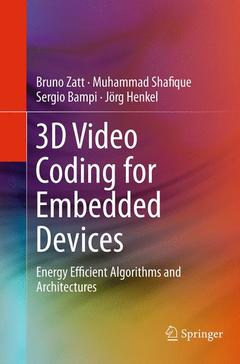Description
3D Video Coding for Embedded Devices, Softcover reprint of the original 1st ed. 2013
Energy Efficient Algorithms and Architectures
Language: English
Subjects for 3D Video Coding for Embedded Devices:
Approximative price 105.49 €
Subject to availability at the publisher.
Add to cart
3D Video Coding for Embedded Devices
Support: Print on demand
Support: Print on demand
3D Video Coding for Embedded Devices
204 p. · 15.5x23.5 cm · Hardback
204 p. · 15.5x23.5 cm · Hardback
Description
/li>Contents
/li>Biography
/li>Comment
/li>
This book shows readers how to develop energy-efficient algorithms and hardware architectures to enable high-definition 3D video coding on resource-constrained embedded devices. Users of the Multiview Video Coding (MVC) standard face the challenge of exploiting its 3D video-specific coding tools for increasing compression efficiency at the cost of increasing computational complexity and, consequently, the energy consumption. This book enables readers to reduce the multiview video coding energy consumption through jointly considering the algorithmic and architectural levels. Coverage includes an introduction to 3D videos and an extensive discussion of the current state-of-the-art of 3D video coding, as well as energy-efficient algorithms for 3D video coding and energy-efficient hardware architecture for 3D video coding.
Introduction.- Background and Related Work.- Multiview Video Coding Analysis for Energy and Quality.- Energy-Effiecient Algorithms for Multiview Video Coding.- Energy-Efficient Architectures for Multiview Video Coding.- Results and Comparison.- Conclusion and future Works.
Multiview Video Coding Analysis for Energy and Quality.- Energy-Efficient Algorithms for Multiview Video Coding.- Energy-Efficient Architecture for Multiview Video Coding.- Results and Comparison.
Discusses challenges related to performance and power in 3D video coding for embedded devices Describes energy-efficient algorithms for reducing computational complexity at multiple hierarchical levels Presents energy-efficient hardware architectures along with methods for reducing on-chip and off-chip energy related to both data processing and memory access Shows how to leverage jointly the algorithm and hardware architecture layers of the system Includes supplementary material: sn.pub/extras
© 2024 LAVOISIER S.A.S.
These books may interest you

Advanced Video Coding Systems 105.49 €

Advanced Video Coding Systems 105.49 €


